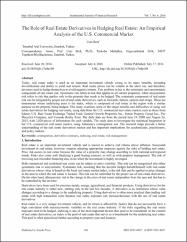| dc.contributor.author | Berk, Cem | en_US |
| dc.date.accessioned | 2017-04-21T10:50:34Z | |
| dc.date.available | 2017-04-21T10:50:34Z | |
| dc.date.issued | 2016 | |
| dc.identifier.citation | Berk, C. (14-16 April 2016). The role of real estate derivatives in hedging real estate: an empirical analysis of the U.S. commercial market. International Journal of Financial Research. 7. 4, 168-174. | en_US |
| dc.identifier.issn | 1923-4031 | |
| dc.identifier.uri | https://hdl.handle.net/20.500.12294/813 | |
| dc.identifier.uri | | |
| dc.description | Conference : Economic and Social Development: 13th International Scientific Conference on Economic and Social Development, Barcelona, 14-16 April 2016. | en_US |
| dc.description.abstract | Today, real estate today is used as an important investment vehicle owing to its many benefits, including diversification and ability to yield real returns. Real estate prices can be volatile in the short run, and therefore, investors need to hedge themselves to avoid negative returns. This problem is due to the systematic and unsystematic components of real estate risk. Systematic risk refers to risk that applies to all similar properties, while unsystematic risk refers to risk that applies only to the property that needs to be hedged. The systematic component of real estate risk can be mitigated by proper use of real estate derivatives, such as forwards, futures, options and swaps. These are instruments whose underlying asset is the index, which is composed of real estate in the region with a similar purpose as the property being hedged. This study examines some of the major benefits and difficulties of using real estate derivatives for hedging real estate, using data from the U.S. commercial real estate market, such as those from Ishares U.S. Real Estate Exchange Traded Fund, General Growth Properties Inc., Simon Property Group Inc., The Macerich Company, and Vornado Realty Trust. The daily data are from the period June 19, 2000 and August 24, 2015, with 3,820 pieces of information for each variable. The study aims to investigate the statistical integration in the U.S. commercial real estate market, using Johansen’s cointegration test. The research helps provide a better understanding of the real estate derivatives market and has important implications for academicians, practitioners, and policy makers. | en_US |
| dc.language.iso | eng | en_US |
| dc.publisher | Sciedu Press | en_US |
| dc.relation.ispartof | International Journal of Financial Research | en_US |
| dc.identifier.doi | | en_US |
| dc.identifier.doi | | |
| dc.rights | info:eu-repo/semantics/openAccess | en_US |
| dc.subject | Cointegration | en_US |
| dc.subject | Derivative Contracts | en_US |
| dc.subject | Indexing | en_US |
| dc.subject | Real Estate | en_US |
| dc.subject | Risk Management | en_US |
| dc.title | THE ROLE OF REAL ESTATE DERIVATIVES IN HEDGING REAL ESTATE: AN EMPIRICAL ANALYSIS OF THE US COMMERCIAL MARKET | en_US |
| dc.type | conferenceObject | en_US |
| dc.department | İstanbul Arel Üniversitesi, Uygulamalı Bilimler Yüksekokulu, Muhasebe Bilgi Sistemleri Bölümü. | en_US |
| dc.authorid | TR217559 | en_US |
| dc.identifier.volume | 7 | en_US |
| dc.identifier.issue | 4 | en_US |
| dc.identifier.startpage | 168 | en_US |
| dc.identifier.endpage | 174 | en_US |
| dc.relation.publicationcategory | Konferans Öğesi - Uluslararası - Kurum Öğretim Elemanı | en_US |
| dc.institutionauthor | Berk, Cem | en_US |


















